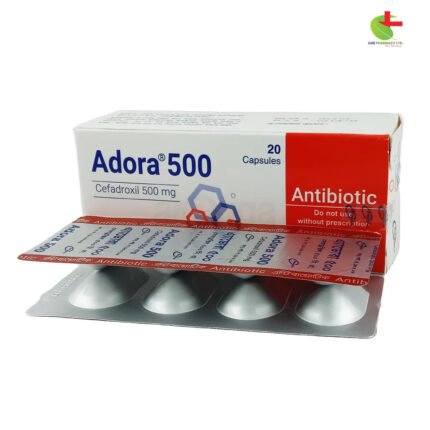Emixef 400
200.00৳ Strip
- Emixef is an orally active third-generation cephalosporin antibiotic effective against a wide range of Gram-positive and Gram-negative bacteria.
- Indicated for the treatment of upper respiratory tract infections, urinary tract infections, and skin infections caused by susceptible organisms.
- High stability against beta-lactamase enzymes provides reliable efficacy where other antibiotics may fail.
- Suitable for both adults and children, offering flexible dosing options for various infection severities.
 Brand
Brand
|
Incepta Pharmaceuticals Ltd |
|---|---|
 Generics
Generics
|
Cefixime Trihydrate |
 Type
Type
|
Capsule |
Indications
Emixef is an orally administered cephalosporin antibiotic known for its potent bactericidal action against a broad spectrum of Gram-positive and Gram-negative organisms. It is recommended for the treatment of acute infections caused by susceptible microorganisms.
- Upper Respiratory Tract Infections (URTI): Suitable for conditions like otitis media and other URTIs, especially when the causative bacteria are resistant to common antibiotics or if there’s a high risk of treatment failure.
- Lower Respiratory Tract Infections: Including bronchitis.
- Urinary Tract Infections: Effective for cystitis, cystourethritis, and pyelonephritis. Emixef has shown clinical efficacy against pathogens such as Streptococcus pneumoniae, Streptococcus pyogenes, Escherichia coli, Proteus mirabilis, Klebsiella species, Haemophilus influenzae (both beta-lactamase positive and negative), Moraxella catarrhalis, and Enterobacter species. It remains stable in the presence of beta-lactamase enzymes.
Pharmacology
Cefixime, the active ingredient in Emixef, is a third-generation, semi-synthetic cephalosporin antibiotic. It exhibits bactericidal properties by disrupting bacterial cell wall synthesis, effectively killing both Gram-positive and Gram-negative bacteria. Resistant organisms due to beta-lactamase enzyme production are often susceptible to Cefixime. Its absorption rate ranges between 40-50%, regardless of food intake.
Dosage & Administration
Food intake does not significantly affect Cefixime’s absorption. The typical treatment duration is 7 days, which may be extended to 14 days if needed.
- Adults & Children over 10 years: 200-400 mg daily, as a single dose or divided into two doses, depending on infection severity.
- Elderly: Dosage is the same as for adults, with careful consideration of renal function.
- Children: The recommended dose is 8 mg/kg/day, either as a single dose or divided into two doses. Guidelines for children are:
- 6 months to 1 year: 3.75 ml daily
- 1-4 years: 5 ml daily
- 5-10 years: 10 ml daily
- Typhoid treatment: 5 mg/kg body weight twice daily for 10-14 days
- Renal Impairment: For patients with a creatinine clearance below 20 ml/min, a dose of 200 mg once daily is recommended.
Interaction
As with other cephalosporins, an increase in prothrombin time has been noted in certain patients. Caution is recommended for those receiving anticoagulant therapy.
Contraindications
Emixef should not be administered to individuals with a known allergy to cephalosporin antibiotics.
Side Effects
Emixef is generally well tolerated. Common side effects include gastrointestinal disturbances like diarrhea, nausea, and abdominal discomfort. Rare cases of pseudomembranous colitis, hypersensitivity reactions, and mild changes in liver and renal function have been reported.
Pregnancy & Lactation
No sufficient studies are available regarding the use of Cefixime during pregnancy. Therefore, it should only be used if absolutely necessary. It is unknown if Cefixime is excreted in human milk, so caution should be exercised during breastfeeding.
Precautions & Warnings
Patients with known sensitivities to other drugs, particularly penicillin, should take Emixef with caution due to potential cross-reactivity. Discontinuation is advised if allergic reactions occur. Overuse of broad-spectrum antibiotics like Emixef can lead to overgrowth of Clostridium difficile, the primary cause of antibiotic-associated diarrhea.
Overdose Effects
In the event of an overdose, gastric lavage may be necessary. Hemodialysis or peritoneal dialysis does not significantly remove Cefixime from circulation.
Therapeutic Class
Third-generation cephalosporins.
Storage Conditions
Store below 30°C, protected from light and moisture. Keep out of reach of children.













Reviews
There are no reviews yet.